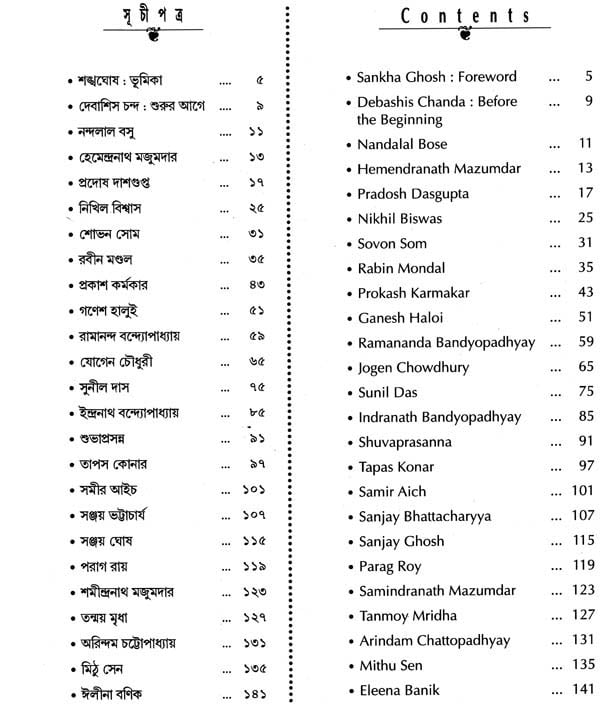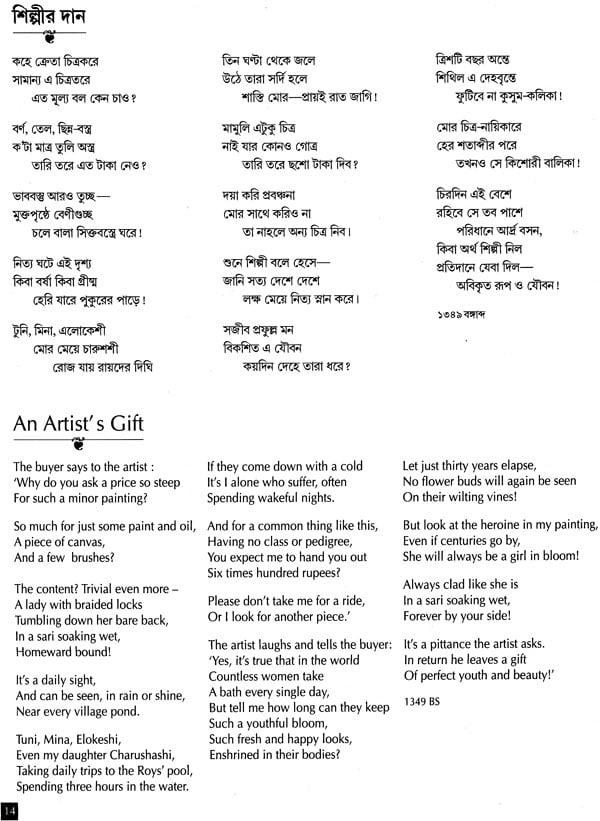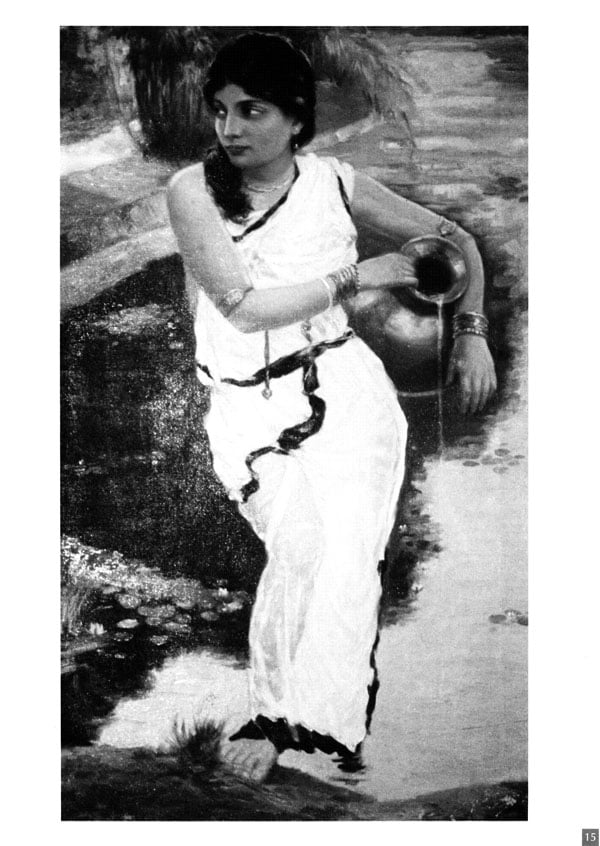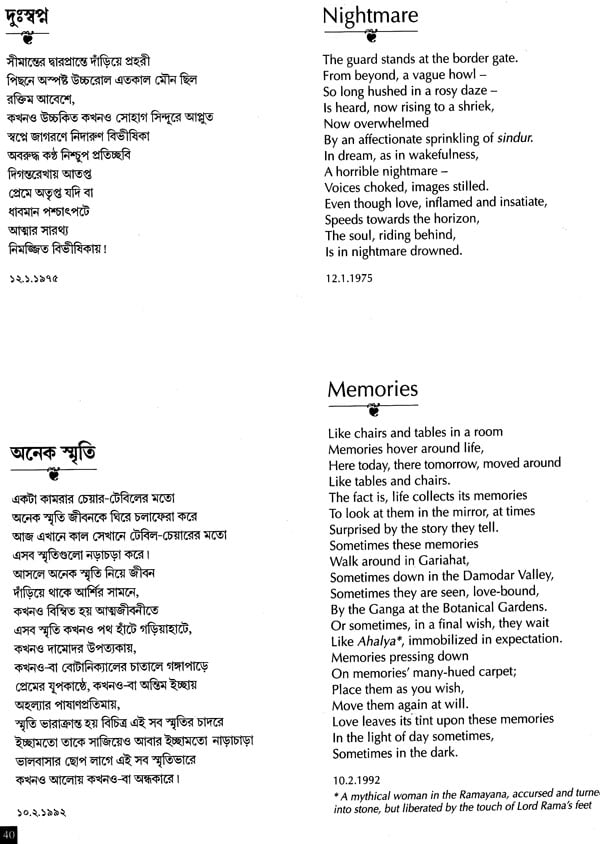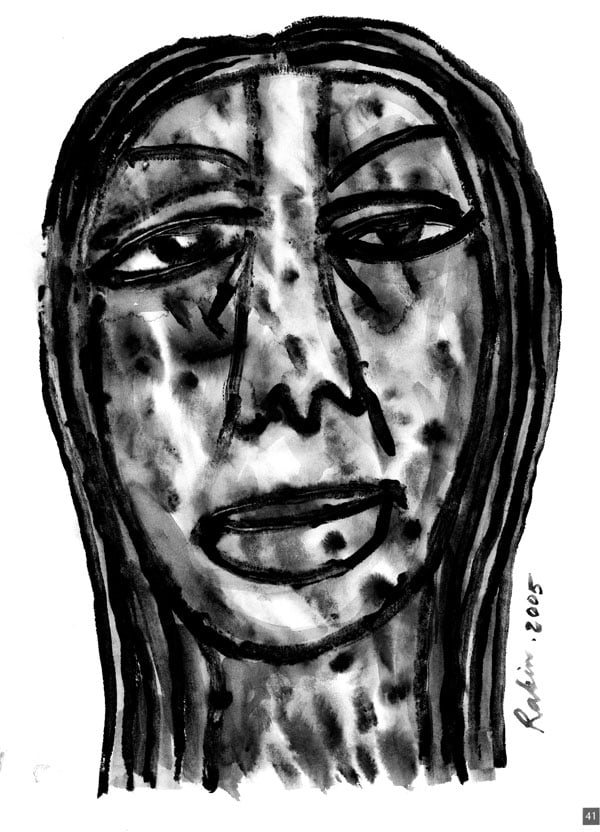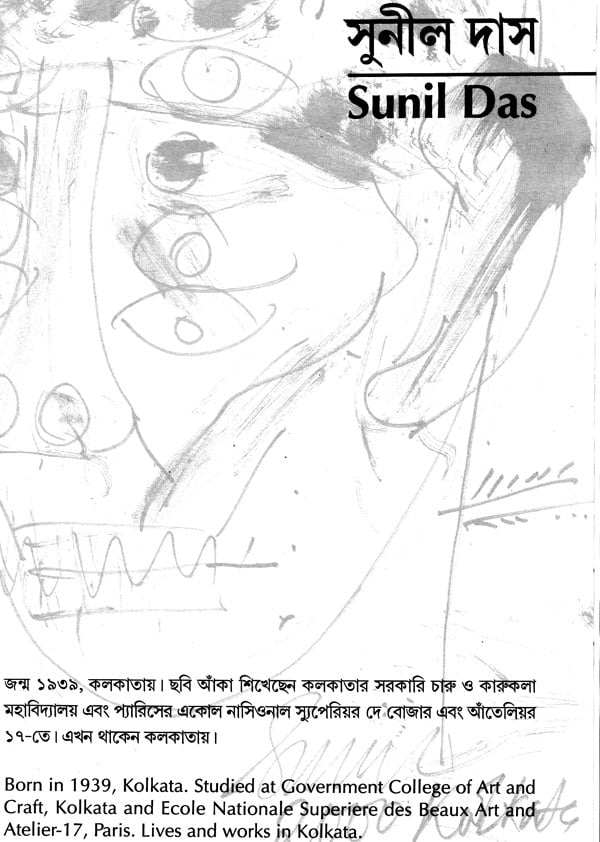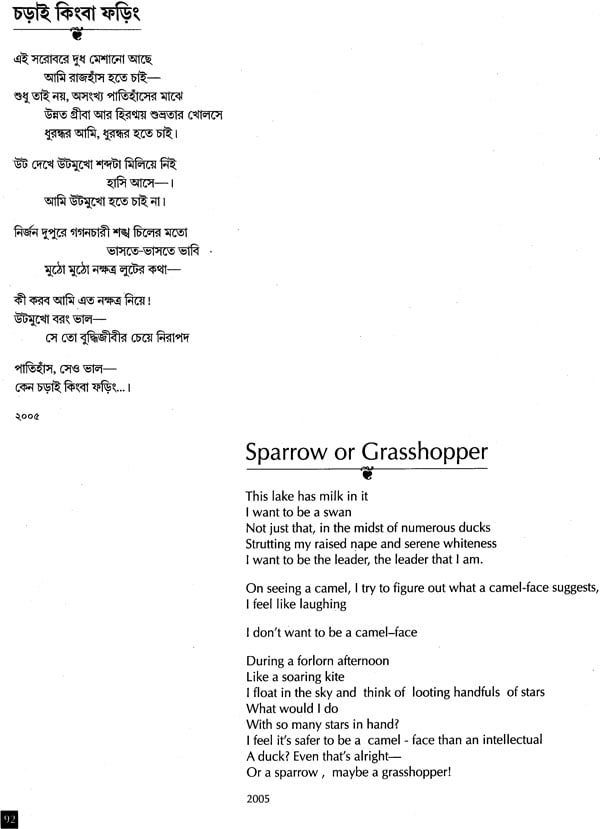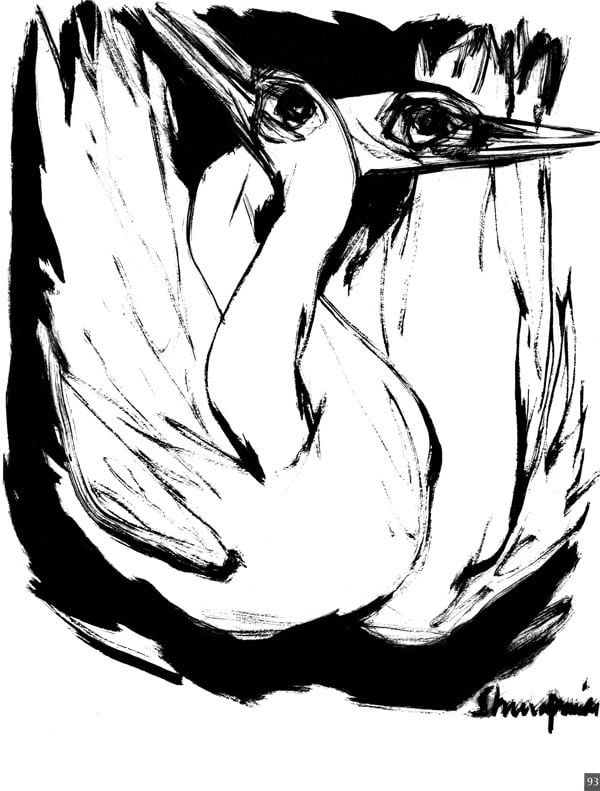
Visual Rhapsody
Book Specification
| Item Code: | NAL149 |
| Author: | Debashis Chanda |
| Publisher: | Trisha |
| Language: | Bengali Text with English Translation |
| Edition: | 2005 |
| ISBN: | 9788190193672 |
| Pages: | 148 (85 B/W Illustrations) |
| Cover: | Hardcover |
| Other Details | 11.0 inch x 8.5 inch |
| Weight | 780 gm |
Book Description
Almost fifty years ago, one of our major poets, Buddhadev Bose put together an anthology of modern Bengali poetry in which he included, to the surprise of many, an extract from Abanindranath Tagore’s writings. Abanindranath was eminent enough as an artist and as a pioneer in art movement. As a writer also, he was well-known for his distinctive prose-style. But none had expected to see his poem included in an anthology, as impeccably compiled as this one.
Of course, Bose had drawn the extract from a prose-piece of Abanindranath. By rearranging the prose extract in short and long lines-familiar in poetry-he sought to demonstrate that Abanindranath’s prose at times was hardly different from poetry. Perhaps a word or two here and there needed pruning, as Buddhadev did in the extract selected by him. But it often happens that even without such editorial intervention we sometimes exclaim: ‘why it is just like poetry!’ when we come across a certain utterance or situation or experience. Stephen Spender, for one, believed that there are in Delacroix’s Journal many passages, the quality of which ‘makes writers envious’. He then quoted a passage and remarked: ‘the last line seems pure poetry’.
Now what happens when Buddhadev tastes pure poetry in Abanindranath’s prose or Spender in Delacroix’s? Why do such prose-pieces seem poetry to them? Not that such questions admit of easy answers. Perhaps some other is at work, apart from the vibes resulting from the coalescences of the right words or a picture similarly forming itself in the reader’s mind. Perhaps our inner being momentarily becomes active touched by this sense, perhaps one gets a suggestion, a hint of more than has been stated, and when this happens, the moment itself grows in to a moment of encountering poetry. However in case of Abanindranath’s, there would have been no need for Buddhadev to discover such moments from Abanindranath’s prose if he had remembered his prose –poems. Even fifty years ago, very few noticed that as early as in 1927, i.e. almost eighty years from now, Abanindranath had started contributing to the periodicals quite a number of prose-poems, which were printed as Word Picture. Does it not shows that Abanindranath, then approaching sixty and at the height of his power and eminence as an artist, wanted to pen a few poems too? But why did he want to do so? For a considerable spell in 1930s, Abanindranath withdrew from the world of paint and brush and busied himself instead in the sphere of words, not merely of poetry. He could no mote derive from painting ‘the delight inherent in overcoming difficulties’. This is what he said to Rabindranath Tagore trying to explain why he had been showing such symptoms and had stopped painting. This reply was bewildering indeed! Talking of exploration of any art- from, can it ever be claimed that all the inherent ‘difficulties’ have been overcome? An artist finds himself confronting barriers of his own making-as it were- closed doors also of new opportunity at which he arrives through experiments and then he strives to force open these doors. And that is the way it ought to be. Rather, what Abanindranath said on a different occasion, perhaps calls for our attention. He remarked, ‘Is an artist obliged only to paint?’ Surge of creativity may often hurtle him into different media of expression. In his youth, Tagore once (1893) light- heartedly wrote that he did not intend to disappoint any of the ‘muses’ , that he longed to try his hand at everything, even painting. Long years later he made good his longing and went on to paint over 2000 painting in a spurt of ‘volcanic eruption’ as Abanindranath characterised it. So this is how a poet wants to step outside poetry and an artist wishes to explore beyond painting. In the history of art and literature there are numerous such instances of border crossing right under our eyes.
Quite a few creative persons assembled in Bharat Bhavan, Bhopal for a few weeks in December, 1983. Invited from different parts of India, some of them were painters, others poets or musicians. The interface that ensued provided an ideal opportunity for an exploratory dialogue between various art-forms. One day, the celebrated painted Swaminathan stood silently outside the hall, under the sky, after a session of classical music. A little later, quite overwhelmed, he remarked, as if in an aside: ‘Though we may paint so many pictures, can we ever capture even an iota of that melody? While music soars our painting falls and lags far behind! What’s the point in painting any more, then?
Of course, the last sentence did not mean that he was about to give up painting. On the contrary, Swaminathan started a new picture the very next day. We only want to draw attention to this sense of discontentment with one’s own work. This is exactly the opposite of what Abanindranath said, it suggests mortification at not being able to overcome difficulties. Swaminathan was certainly aware of Leonardo Da vinci’s position that music can never get precedence over painting, but came only next to it. Since the eye has pride of place among the sense organs, painting is greater than music- so ran his thoughts. And how about poetry? Poets? ... the poet ranks far below the painter in the representation of visible things, and far below the musician in that of invisible things!’
But it’s not a question of before and after, higher or lower. Every art form is supreme in its domain. Painters often feel an acute urge to capture the invisible in the form of the visible, as Swaminathan did that day. And musicians, too long to render the invisible, they often glimpse shape and form in the ragas. Poetry also aspires to grasp both, simultaneously. Each art form has its own varied ways of approaching the Eternal Truth. Only the ways and techniques are different. Aware of these differences, each art form tends to look somewhat askance at the others. When an artist feels that he has not been able to sufficiently capture the elusive form, he suddenly decides to explore other avenues or media for some time. It does not mean that he has discarded his chosen art form, but it certainly means that driven by curiosity, he is trying to find out whether his mind reflects better in some other art, some other medium. And these sallies, beginning in curiosity, sometimes bring before us magnificent painters like Tagore or Blake or poet like Michelangelo.
Leonardo Da vinci devoted considerable thought to coordinates in painting. That he accorded pride of place to painting in the world of art must have something to do with the age itself. ‘Painting is dumb poetry’ was an ancient saying. Rebutting claims that painting was a ‘mechanical art’ or that it was dumb poetry, he indignantly declared, ‘If you call painting dumb poetry, the painter may call poetry blind painting. ‘But Leonardo’s rebuttal accounts for only half of the old saying which in its entirety runs, ‘Painting is dumb poetry and poetry speaking painting. If the negative nuance is ignored, this can even be called a positive characterisation, a statement of the inherent complementary relationship between poetry and painting. A painting may well call forth in one the same ineffable feelings that assail one after reading a poem. Their themes and ingredients are different, so are the methods employed. Yet, when two different art forms take you by different routes to the same destination, it won’t be wrong to say that there are pictures in poetry too and these pictures speak; there is poetry in painting also, but this poetry is silent. If we use ‘silent’ instead of ‘dumb’, the problems tend to disappear, and then we can perhaps try to forge an interrelationship between these two arts.
However, Leonardo said something more about the differences between painting and poetry (or music). He said, ‘Both verse and voice proceed through time in rhythmical formation. The painter does not express himself in rhythmical divisions of time but he may infuse rhythm into the contours of his figures. The term ‘space’ has not been used here in the context of painting, but Lessing covered a good deal of ground by pursuing the theme of the difference between time and space while elaborating on the characteristics of these art forms. And taking his cue from Lessing Rabindranath accounts for this difference when he explains that in music or painting ‘the external state of being of only a moment can be expressed’. But what about poetry? Poetry functions on a much wider scale. A poet graduates from feeling to feeling, from one state of mind to another. ‘His poetry deals with moving bodies, streams of consciousness, changing circumstances.’ That the poet can do it is because he hangs on to time. As Lessing puts it, the difference between a painter and a poet is ‘the one using forms and colours in space, the other articulates sounds in time,’
When we see a picture, we can take in the entire canvas or space at a glance. In a poem, on the other hand, this process of ‘taking in’ proceeds little by little’ opening up one layer after another from beginning to end. While bearing this distinction in mind a poet or painter can still invest one art form with the characteristics of another. Titian’s famous painting Prodigal Son is, according to Lessing an example of how painting recreates a large span of time where the entire sequence of past and present is recaptured in action. But he terms this an ‘encroachment’. We may not agree with this position. We may be inclined to believe that modern painting also uses time in intricate ways. An abstraction can surmount the limitation of time in pictures. It is, perhaps, not impossible to capture the mobility of time in painting: likewise is possible to represent space in verse.
So there is always room for inter-disciplinary opportunities or a willingness to create such opportunities where movements in a painting and poetry go so much hand in hand. Are the much –talked about movements –Impressionism, Dadaism, Surrealism-only art movements or poetry movements? Surely these penetrate both poetry and painting. Writing about Delacroix, Baudelaire once said that the spirit of our age was such that the different art forms tended to infuse fresh power into each other. And thus it seems all very natural to us that Mallarme ‘dropped by Degas’ studio almost every day, that Salvador Dali was a close friend of Lorca’s or that Rilke wrote continuously about the painting of Cezanne. In the Kolkata ambience we’ve seen how Jamini Roy and Bishnu De were inseparable from one another, how the artists of the ‘Calcutta Group’ took to Bishnu De as their ‘friend , philosopher and guide’, how the young poets and artists in the mid-60s wrer keen to create a space where they could meet and rub shoulders ofren enough. Consequently, apart from trying to understand each other better, sometimes it is seen that Bishnu De turns out a hundred paintings or that the sculptor Pradosh Dasgupta ends up writing a number of poens in which we can hear-or see – ‘those Iconic eyes of Byzantine sadness’! In a way, this fulfils what Baudelaire called the spirit of the age.
